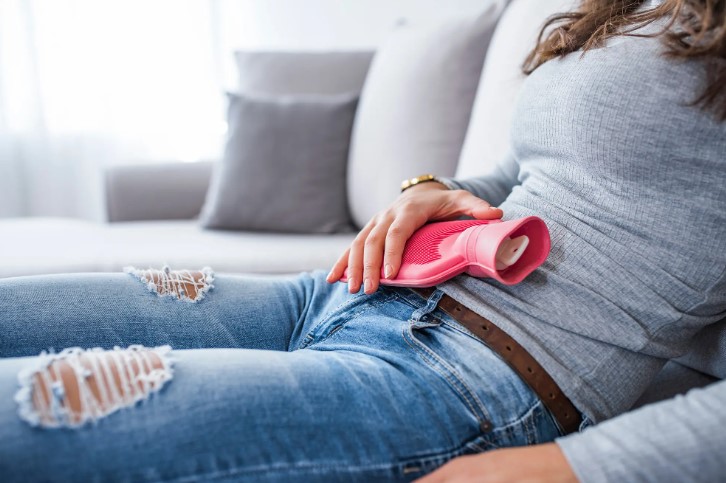That time of the month – never fun and always inconvenient.
Apart from changing your bathroom habits, there are a few more annoying period symptoms. Food cravings, sleep issues, bloating, mood swings (typically anger), exhaustion, sensitive breasts, and more are warning indications of impending menstruation. The majority of these symptoms begin even before your period begins.
Then there are the cramps.
Your time of the month is definitely the worst if you’re one of the one in eight women who get period pains during your monthly cycle.
Let’s understand the period cramps symptoms, causes, and care tips to get rid of them.
What are Period Cramps?
Every month, as part of the regular reproductive cycle, a woman’s body gets ready for conception. Menstruation, often known as a period, is a well-known aspect of this process because it’s the time when the uterus sheds its lining.
It happens to assist in preparing the uterus to receive and support a fertilized egg.
Period cramps, also known as dysmenorrhea, refer to the pain and discomfort experienced by many women before or during their menstrual period. The contraction of the uterine muscles causes these cramps as the body works to shed the uterine lining.
What are the Causes of Period Cramps?
The contraction of the uterine muscles primarily causes period cramps. The uterus contracts to help shed its lining during menstruation.
However, when these contractions are too strong, they can lead to pain and discomfort. You can consult the best gynecologist in Karachi if your cramps are severe.
Prostaglandins, hormone-like substances, play a significant role in these contractions. High levels of prostaglandins can intensify uterine muscle contractions, contributing to more severe cramps.
Other factors that may contribute to period cramps include an underlying medical condition such as endometriosis or pelvic inflammatory disease, as well as lifestyle factors like stress and lack of physical activity.
What are the Symptoms of Period Cramps?
You can understand period cramps through these symptoms:
-
Pain in the lower abdomen: The most common symptom of period cramps is a dull or throbbing pain in the lower abdomen. This pain can range from mild to severe and may radiate to the lower back and thighs.
-
Menstrual cramp intensity: The severity of cramps can vary from one woman to another and from one menstrual cycle to the next. Some may experience mild discomfort, while others may face debilitating pain.
-
Gastrointestinal symptoms: Period cramps can bring gastrointestinal symptoms like nausea, vomiting, and diarrhea. Studies suggest these symptoms occur due to the release of prostaglandins.
-
Fatigue and headache: Many women also experience fatigue and headaches during their menstrual periods, which can further contribute to a sense of overall discomfort.
Tips to Get Rid of Period Cramps
You can try these care tips to help alleviate the pain associated with periods:
Apply Heat therapy
Applying heat to the lower abdomen can help relax the uterine muscles, reducing cramp pain. Use a hot water bottle, heating pad, or warm bath to ease discomfort. The warmth promotes blood circulation, helping to soothe tense muscles.
Stay Hydrated
Adequate hydration is essential for overall health. It can also help alleviate period cramps. Water helps prevent water retention and bloating, common symptoms associated with menstruation.
Exercise Regularly
Engaging in regular physical activity has been shown to reduce the severity and duration of period cramps.
Exercise releases endorphins, which act as natural pain relievers. Focus on activities like walking, jogging, yoga, or swimming.
Dietary Changes
Adopting a balanced and nutritious diet can positively impact menstrual health. Include foods rich in omega-3 fatty acids, calcium, and vitamins.
Additionally, reduce the consumption of caffeine, alcohol, and salty foods, as they may exacerbate cramp symptoms.
Herbal Remedies
Some herbal supplements, such as ginger and chamomile, are believed to have anti-inflammatory and muscle-relaxant properties. Teas or supplements containing these herbs may help alleviate period cramps.
Consult with a healthcare provider before incorporating new supplements into your routine.
Practice Relaxation Techniques
Stress can exacerbate period cramps, so incorporating relaxation techniques can be beneficial.
Techniques like deep breathing, meditation, and progressive muscle relaxation can help manage stress levels and reduce cramp intensity.
Aromatherapy
Certain essential oils, such as lavender and peppermint, are known for their relaxing properties. Incorporating aromatherapy through diffusers or topical application of diluted essential oils may relieve period cramps.
Ensure you are not allergic to essential oils and consult a healthcare professional if needed.
Final Thoughts
Period cramps are a common aspect of menstruation that you can manage with proactive self-care.
By understanding the causes and symptoms of period cramps and implementing these practical tips, you can get through your menstrual cycle more comfortably and confidently.
You should listen to your body and get professional advice if your cramps are severe or persistent. With care, you can minimize the impact of period cramps and maintain your well-being throughout your menstrual cycle.


